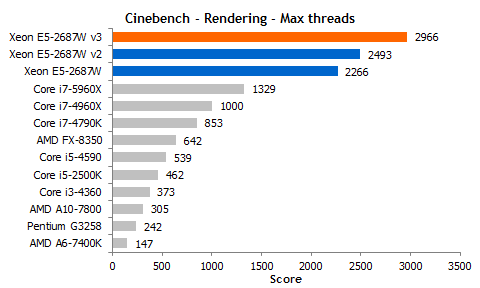Intel’s new 18-core Haswell Xeon chips will try to preempt the ARM server onslaught
Intel has released a new batch of Xeon chips — the Xeon E5 v3 range – and by all accounts it’s the most impressive set of server products the company has shipped in years. While these new chips are based on the now-familiar Haswell core, they aren’t just retreads of existing silicon — Intel has pushed core counts all the way up to 18 cores per socket, integrated sophisticated new Turbo mechanisms, added new forms of cache monitoring, moved its entire platform over to DDR4, and can individually gate each CPU core for maximum power savings.
With up to 45MB of L3 and a dual ring bus that uses multiple interfaces to maximize inter-chip bandwidth, the Xeon E5 v3 (Haswell-EP) lineup is a truly formidable slice of silicon. Tech Report reports (sorry) that Intel has even implemented a cluster-on-die option that gives users more fine-grained control over which domain threads execute within (Intel reports single-digit performance gains in some cases from fine-tuning the chip in such fashion).
Combine the new features and higher core counts, and the Haswell-EP family tears through its own predecessors, exceeding performance on Xeon parts just a year old by as much as 20%.

Image courtesy of Tech Report
The gains don’t apply in every scenario or situation — much as we saw with Haswell-E, there are cases where higher core clocks and smaller thread counts carry the day. What I find most interesting about the hardware, however, is the way that Intel is clearly moving to shore up its enterprise divisions against the oncoming ARM server push.
Locking up the high end
Calxeda may have collapsed but it’s not the only ARM server company looking to make a name for itself. AMD has its own ARM products set to deploy in 2015 with a custom ARM core following in 2016. The newcomer Cavium is prepping its ARM-based ThunderX core, and there are rumors that Google and Facebook might build custom servers of their own. AppliedMicro’s X-Gene is also finally set to start shipping on 28nm (40nm parts are already available).
None of these parts are a threat to Intel’s server business as it exists today — in fact, they all face substantial scaling challenges and a dire need for ecosystem development that will limit sales and shipments in the first few years. All the price/performance advantages in the world don’t mean much if a new CPU doesn’t support the full range of software that needs to run on it, and Intel is fully aware of it.
Just because ARM poses no serious threat in 2015-2016, however, doesn’t mean it couldn’t be facing a longer-term strategic competitor — and that’s one reason why Intel is migrating what used to be EX-class features and capabilities into the more mainstream EP segment. (The photo at the top of the story, incidentally, is 15-core Xeon E7 Ivy Bridge-EX chip.)

The new Haswell-EP ring bus design and core counts
The reason I think it’s fair to judge these new Haswell-EP parts as part of Intel’s opening gambit against an ARM threat is that the server market tends to move more slowly and deliberately than desktop or consumer spaces. Tablet market share can change in a matter of months if a particularly popular Android or iOS device launches, but workstation and enterprise server deployments tend to be long-term affairs. With its huge set of new SKUs and capabilities, Intel has launched a series of parts that dares up-and-coming players to try and match them.
It’s a daring move. Rather than simply retrenching and fighting on clock speed or core count, the Haswell-EP family is designed to stretch from low-power, high-efficiency cores to massive 18-core monsters — and all of this is on the midrange server platform.
If Intel’s strategy works, it won’t keep ARM products from gaining any market share at all — but it could end up confining them to the less profitable segments of the market — just as Chipzilla successfully confined AMD more than ten years ago.








